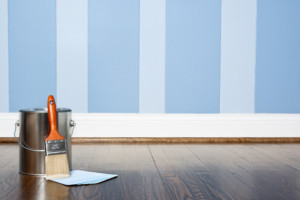Painting a wall seems easy. You buy some paint, use a brush, and just do it. If you ask the pros though, they’ll tell you these top wall painting secrets.
When painting, the color you choose can have a dramatic impact on your mood and overall feeling.
Studies have shown brighter colors can make people feel more upbeat, while darker colors can make you feel sad.
The color you choose to paint with is essential, but it’s only half the battle, to truly add to the ambiance of a room it must have a professional paint job.
Painting a room does seem like an easy task until you have paint streaks and botched layers. If you ask the professionals, they will give you these expert wall painting tips to make sure it comes out neat and elegant looking every time.
Wall Painting: An Experts Guide
Each painter has a particular way of painting that they believe to be the best. They all have specific brush techniques and methods of preparing that they perform time after time. How do we know what techniques are the best?
Follow along with this expert guide that is dedicated to helping you get the perfect paint job every time.
Preparation
When it comes to preparing to paint a wall, you can look at like preparing for war. It is one of the most critical steps to make sure you get the perfect paint job. If you miss a step or get lazy, you might have paint leak through your barriers, and that’s a big problem.
So its best to put in the work, in the beginning, to make sure the rest of the process is smooth sailing.
First, you should inspect the walls to make sure they are not any holes, cracks, or rough spots. If you find holes, make sure to fill them in along with any cracks. If you have paint that’s chipping, you can go ahead and peel it away. Any spots you find can be easily cleaned with a non-toxic cleaner.
Make sure to lightly sand down any rough spots you find to ensure you have a clean, smooth surface to work with.
Protect Your Assets
When you are finished preparing the wall, its time to move on to taping. To make sure your painting tape holds, its recommended to get a high-quality tape such as frog tape. You can then go along baseboards, molding, doors, window frames, light fixtures, and switch plates.
When it comes to taping, the better edge you create, the better the results will be in the end. Don’t skimp out on the taping portion.
Next, move any furniture in the area if you can to another room. If moving the furniture to another room isn’t an option, make sure to cover it with a plastic throw.
When you feel comfortable with your furniture being protected, throw a drop cloth down on the floors to protect them as well.
Time to Begin Painting
Time to open up the paint can and begin painting. It is a smart idea to pour the paint into a ramp. The ramp helps when painting a wall to ensure the paint is evenly distributed throughout the entire wall.
An important thing to keep in mind when choosing a roller is to look for one that has “shedless” on the label. A shedless roller is higher quality and will make sure you don’t have any unwanted fibers coming off the roller and sticking to the wall.
When you begin to paint, starting at the top and working your way down is the proper way to paint a wall. It is best to work on the ceiling first and work your way down from there.
Technique, Technique, Technique
The technique is what separates the professionals from amateurs. One of the techniques professionals use is called “cutting in.” This technique helps protect the trim and edges by painting straight lines alongside them, eliminating the need to go over it multiple times.
With the cutting in process, you paint the top and bottom first using straight lines and then fill in the middle using a roller.
Another technique that professionals use is called keeping a “wet edge.” This technique involves keeping the “cut in” portion wet to maintain the working area of the wall.
If you do not keep a wet edge while painting, it will give the wall different layers, and ruin the look of it.
Using these professional painting tips will help maintain a professional look while also maximizing efficiency.
Wrapping up
While you finish up your painting job, it is essential to remember the job isn’t finished quite yet. It is recommended not to touch freshly painted walls for at least 2 hours after you finish. It is best if you can leave it overnight to avoid any unwanted streaks.
If possible, you can leave the windows open to help circulate the air. If it is humid outside, it is not recommended to open the windows.
When the humidity is high, the air contains more water vapors and can affect the finish of your paint job. Due to the increased moisture in the air, the paint can take longer to dry as well.
When finished with your tools, it is recommended to soak them in hot or warm water to get the excess paint off. Most paint will come right off with a little water because many paints are water-based in this day in age.
If needed, you can use a little bit of mild soap for stubborn paint that won’t come off. Cleaning your tools immediately after your finished ensures you keep the integrity of the tools, and they will be ready to use for your next paint job.
When finished with your paint, you can put the lid back on with a little tap from a hammer. Make sure the cover is on tight, and paint can last up to another two years once opened.
When The Professionals Are Needed
After reading through this guide, you will have learned how to properly paint a wall. Keep in mind though some paint jobs are harder than others, don’t get discouraged if you have a massive project.
That is what the professionals are here for, if you need assistance with wall painting, contact us today, and we can help.

